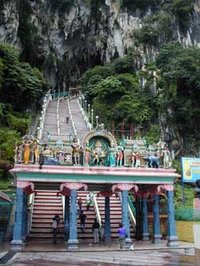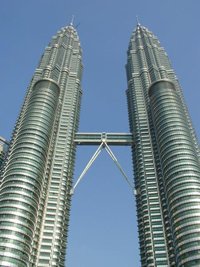Kuala Lumpur
|
|
| |||||
| Missing image Map_malaysia_kuala_lumpur.jpg | |||||
| Mayor | Datuk Ruslin Hasan | ||||
| District | Kuala Lumpur District | ||||
| Area - Total (City) | 243.65 km² | ||||
| Population
- City (2004)
| 1,479,388 1,500,000 | ||||
| Time zone | UTC+8 | ||||
| Latitude | 3°8' N | ||||
| Longitude | 101°42' E | ||||
Kuala Lumpur (Jawi:كوالا لمڤور is the largest city in Malaysia and the capital of the federation. Within Malaysia, Kuala Lumpur is almost always abbreviated to KL. The executive branch of the Malaysian Government has shifted to a new administrative capital, Putrajaya, but the residence of the King of Malaysia, the Parliament of Malaysia, and the judicial branch remain in Kuala Lumpur.
Kuala Lumpur is one of the three Federal Territories, and is an enclave within the state of Selangor, on the central west coast of Peninsular Malaysia.
| Contents |
History
PICT2413.JPG
Kuala Lumpur was founded in 1857 at the confluence of the Gombak and Kelang rivers. In Malay, the name means "muddy confluence". The settlement started when a member of the Selangor royal family, Raja Abdullah, opened up the Klang valley for tin prospectors. 87 Chinese prospectors went up the river Klang and began prospecting in the Ampang area, which was then jungle. Despite 69 of them dying due to the pestilential conditions, a thriving tin mine was established. This naturally attracted merchants who traded basic provisions to the miners in return for some of the tin. The traders set up shop at the confluence of the Klang and Gombak rivers. Thus was a city born.
As the town grew, the British, who ruled Malaya at the time, felt the need to appoint a headman (called the Kapitan Cina, or Captain of the Chinese) to administer the settlement and ensure law and order. The first Kapitan Cina was Hiu Siew. It was the third Kapitan Cina, Yap Ah Loy, who oversaw the rise of Kuala Lumpur from a sleepy little mining town to become the foremost city of Selangor. In the early years, Kuala Lumpur was the centre of the Selangor Civil War, in which two conflicts could be discerned; a fight between Selangor princes over the revenue of tin mines, and the other one a vendetta between Kapitan Yap and Chong Chong, who wanted the Kapitanship. Kapitan Yap and his backer, Tengku Kudin, were successful and it was from then, thanks to Kapitan Yap's able leadership, that Kuala Lumpur became Selangor's biggest city. He rebuilt Kuala Lumpur, which was devastated by the Civil War and repopulated it with Chinese miners from elsewhere in Selangor. He also encouraged Malay farmers to settle near Kuala Lumpur in order to have a steady and accessible source of food.
PICT2411.JPG
It was made capital of Selangor in 1880 due to Kapitan Yap's success. He gave Kuala Lumpur a system of frontier justice which effectively maintained law and order, and ensured that Kuala Lumpur became the centre of commerce in Selangor. After Kuala Lumpur burnt down in 1881, Kapitan Yap decided to rebuild Kuala Lumpur in brick and tile to replace the dangerous attap houses. He set up Kuala Lumpur's first school and a shelter for the homeless. Yap's Kuala Lumpur was very much a rough frontier town as Yap himself was a member of the Hai San triad and gang warfare was common. Kapitan Yap licensed brothels, casinos and drinking saloons. Sir Frank Swettenham was at this time appointed Resident of Selangor and he was the person responsible for making Kuala Lumpur the seat of administration of Selangor. It was under his rule that after Kapitan Yap's death the city continued to prosper. When the Federated Malay States were incorporated with Swettenham in charge in 1896, Kuala Lumpur was made the capital.
PICT2454.JPG
During World War II Japanese forces captured Kuala Lumpur on January 11, 1942 and occupied the city for 44 months.
After independence in 1957, Kuala Lumpur was the capital of the Federation of Malaya and continued to be the capital of the renamed Federation of Malaysia in 1963. For the occasion of independence, A large stadium, Stadium Merdeka (Independence Stadium), was built, where Malaysia's first prime Minister, Tunku Abdul Rahman, declared Malaya's independence in front of a massive crowd. The Union Jack was lowered from the flagpole at the Padang (now known as Dataran Merdeka; Independence Square) and the Malayan flag was raised. The Padang symbolized British sovereignty as it was a cricket ground for the colonial administrators and fronted the Royal Selangor Club, Malaya's most exclusive Whites-Only club.
In 1974 Kuala Lumpur seceded from Selangor and the city became a Federal Territory (Wilayah Persekutuan).
KL_view_from_Skybridge.jpg
Kuala Lumpur has advanced by leaps and bounds ever since the Asian Economic Boom of the early 1990s (when Malaysia was averaging 10% economic growth). Skyscrapers have shot up and Kuala Lumpur, formerly a languid colonial outpost, has become one of the most lively, advanced and vibrant cities in South East Asia. Unfortunately the infrastructure has barely been able to keep up with this rapid growth, although a new rapid transit system was built in the 1990s. Traffic jams are a scourge commuters endure daily, despite the numerous 6-lane highways constructed all over the city (including two elevated highways). Bus services are notoriously irregular and inadequate and water quality has suffered severely.
Most of central KL has grown without any central planning whatsoever, so the streets in the older parts of town are extremely narrow, winding and congested. The architecture in this section is a unique colonial type, a hybrid of European and Chinese forms.
The stretch of road facing Dataran Merdeka (Independence Square) is perhaps the most famous road in Kuala Lumpur. The Federal Court (the highest court in the federation) building with its signature copper domes and Moorish architecture stands here, as does one of the tallest flagpoles in the world, which stands in the Dataran Merdeka itself. The Dayabumi building is visible, being down the road. This area used to be the focal point of Malaysia's Hari Merdeka (Independence Day) parade, which was televised all over Malaysia. In 2003 however, the parade was moved to the Boulevard in Putrajaya, in keeping with Putrajaya's status as the new administrative capital of Malaysia. Interestingly, the white Police Headquarters located atop Bukit Aman (literally 'Peace Hill') faces the Dataran.
The rest of the city has mostly developed in the standard way, with the standard skyscraper format. Aware of this, architects have been urged to incorporate traditional design elements into their work. Notable examples of this fusion are the Dayabumi building, Kuala Lumpur's first skyscraper, the Tabung Haji Building and Menara Telekom, both designed by local architect Hijjas Kasturi, and, of course, the Petronas Twin Towers.
Statistics
Malaysia_Masjid_Negara.jpg
(As of 2000)
- Area: 243.65 km²
- Population (Metropolitan area only): 1,479,388; (Klang Valley Conurbation): approximately 4 million
Transportation
The city is served by Kuala Lumpur International Airport, in Sepang, which is accessible via the KLIA Ekspres train service. The city was formerly served by the Sultan Abdul Aziz Shah Airport in Subang Jaya.
Taxicabs are a reliable and fairly cheap method of transport for the newcomer to the city. However, traffic jams are fairly common with KL. Alternatives are the three light rail systems: Putra LRT, Star LRT and the monorail.
A new transit hub has been built in the Brickfields area named KL Sentral. It serves the KTM Komuter commuter train system, the Putra Line of the LRT and the Monorail. Intercity rail journeys have their terminus here.
Those wishing to take buses to elsewhere in Malaysia should note that there are several bus stations such as Puduraya which is badly maintained, depending on which part of peninsular Malaysia you wish to travel to. Most express buses now terminate at the new Imbi bus terminal at Pasar Rakyat, which opened in January 2004.
Tourist attractions

There are popular tourist locations in and around Kuala Lumpur.
- The Golden Triangle, the commercial hub of the city, contains the famed Petronas Twin Towers and has a hectic nightlife.
- The Petronas Twin Towers are the world's tallest twin towers and stand adjacent to one of the busiest shopping malls in Malaysia, Suria KLCC.
- The Menara Kuala Lumpur, the fifth tallest telecommunication tower, is located on Bukit Nanas.
- Lake Gardens, a 92-hectare manicured garden near the Malaysian Parliament building, was once home to a British colonial official. They include a Butterfly Park, Deer Park, Orchid Garden, Hibiscus Garden and South-East Asia's largest Bird Park.
- The sports Stadium Merdeka (Independence Stadium), was initially erected for the country's declaration of independence on August 31, 1957.
- Dataran Merdeka (Independence Square), was the site of the lowering of the Union Jack flag and hoisting of the Malayan flag on the start of August 31, 1957. The square itself has historic association with its surroundings, namely the Royal Selangor Club and the architecturally Victorian-Moorish or 'Raj' influenced Sultan Abdul Samad Building.
- Kuala Lumpur Railway Station, a Victorian-Moorish railway station, was completed in 1911, and surpassed by KL Sentral in 2001; it currently serves commuter trains only.
- The Muzium Negara (National Musuem) incorporates neo traditionalism into its architectural design.
- The Masjid Negara (National Mosque), a post modernist mosque, was completed in 1965.
- The Tugu Negara or the National Monument commemorates those who died in Malaysia's struggles for freedom (principally against the Japanese occupation and during the Malayan Emergency of 1946-60).
- Many of the largest celebrations of Chinese cultural festivals are held at the Thean Hou Temple on Robson Hill.
- The Chinese Night Market area (Chinatown), Petaling Street, has recently undergone a makeover; the most notable feature is the new covered walkway.
- Cheap hawker food on the street is sold at Jalan Alor.
- The Batu Caves are a series of tall limestone caves, home to a Hindu temple, that lie 13 kilometres north of Kuala Lumpur.
- About 40 kilometres west of Kuala Lumpur is the city of Shah Alam, site of a famous masjid (mosque) and 10 kilometres away from Shah Alam is the town of Klang famous for its seafood and Bah Kut Teh (Pork rib soup).
- Genting Highlands is a hill top resort near Kuala Lumpur, famous for its casino and golf course.
External link
- Geographia Article (http://www.geographia.com/malaysia/kualalumpur.html)
- Lonely Planet - Kuala Lumpur (http://www.lonelyplanet.com/destinations/south_east_asia/kuala_lumpur/)
- VisionKL (http://www.visionkl.com/)
- Kuala Lumpur Hotels (http://www.kualalumpur.travelreporter.com/)
- Hotels and accommodation for Kuala Lumpur (http://www.kuala-lumpur.ws/)
- Template:Wikitravel
| States and Federal Territories of Malaysia | 
| ||||
|---|---|---|---|---|---|
| |||||
de:Kuala Lumpur es:Kuala Lumpur fr:Kuala Lumpur ko:콸라룸푸르 id:Kuala Lumpur he:קואלה לומפור ms:Kuala Lumpur nl:Kuala Lumpur (stad) ja:クアラルンプール pl:Kuala Lumpur pt:Kuala Lumpur ro:Kuala Lumpur ru:Куала-Лумпур simple:Kuala Lumpur sk:Kuala Lumpur sv:Kuala Lumpur zh:吉隆坡

